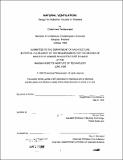Natural ventilation : design for suburban houses in Thailand
Author(s)
Tantasavasdi, Chalermwat, 1971-
DownloadFull printable version (19.70Mb)
Alternative title
Design for suburban houses in Thailand
Other Contributors
Massachusetts Institute of Technology. Dept. of Architecture.
Advisor
Qinyan Chen.
Terms of use
Metadata
Show full item recordAbstract
Natural Ventilation is the most effective passive cooling design strategy for architecture in hot and humid climates. In Thailand, natural ventilation has been the most essential element in the vernacular architecture such as the traditional house, but has become unused nowadays because of the urbanized conditions in big cities like Bangkok. This thesis explores the potential of using natural ventilation for modern houses by using a Computational Fluid Dynamics (CFD) program. The research investigates the characteristics of Thai houses from the past to the present that climate, culture and technology have influenced. The analysis of the climate data concludes that natural ventilation can be used approximately four months a year to create conditions within the zone of thermal comfort. In a suburban housing project, site planning has a significant impact on the wind pattern and velocity. The simulation results indicate that the wind has better characteristics in the houses with square shapes than those with rectangular shapes. The vegetation around the houses also has some effect on the wind by slightly reducing its speed. Lastly, the prevailing winds from the north and north-northeast have similar wind patterns in a large housing project. The final stage is to design a prototype by using some climatic characteristics from the traditional Thai house. The air movement is inadequate in a house with regular size windows. Therefore, the study tests three more cases with larger windows. The results demonstrate that the maximum size window provides better thermal comfort. Finally, the study finds that the stack effect is negligible. The study shows the possibility to use natural ventilation for the houses in this region. The investigation has developed comprehensive design guidelines for architects. Necessary further research is presented in the end to find more solutions for climate-responsive architecture in today's physical conditions.
Description
Thesis (M.S.)--Massachusetts Institute of Technology, Dept. of Architecture, 1998. Includes bibliographical references (p. 93-95).
Date issued
1998Department
Massachusetts Institute of Technology. Department of ArchitecturePublisher
Massachusetts Institute of Technology
Keywords
Architecture.